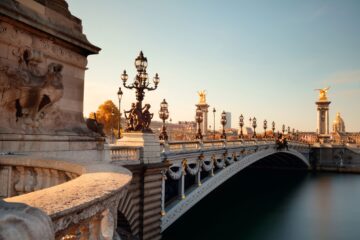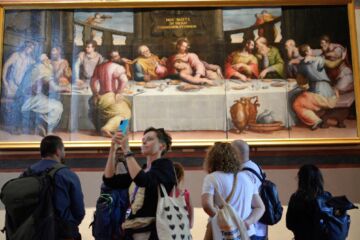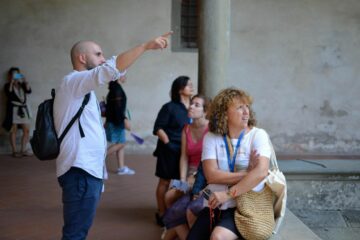
Erasmus Courses for Teachers in Paris, France
Confirmed Sessions in Paris
| Confirmed Course | Starting Date | Status | Enrolment | ||
|---|---|---|---|---|---|
| Teaching European Citizenship in the Classroom | 14 Jul 2025 | 2025-07-14 | 0 | Register here » | |
| Integrating Digital Sustainability into Teaching | 21 Jul 2025 | 2025-07-21 | 0 | Register here » | |
| Artificial Intelligence for Education: Exploring… | 28 Jul 2025 | 2025-07-28 | 0 | Register here » | |
| Bring Mindfulness to Your Class with Practical A… | 18 Aug 2025 | 2025-08-18 | 0 | Register here » | |
| Understanding and Supporting Students With ASD a… | 18 Aug 2025 | 2025-08-18 | 0 | Register here » | |
| Artificial Intelligence for Education: Exploring… | 22 Sep 2025 | 2025-09-22 | 0 | Register here » | |
| 4Cs Education with AI Tools and Storytelling Tec… | 27 Oct 2025 | 2025-10-27 | 0 | Register here » | |
| From STEM to STEAM Education: a New Learning App… | 3 Nov 2025 | 2025-11-03 | 0 | Register here » | |
| Teaching European Citizenship in the Classroom | 11 May 2026 | 2026-05-11 | 0 | Register here » |
What is included
More info
Please note that while these services apply to most courses, exceptions may occur. Even in locations where we have dedicated classrooms, we may occasionally need to rent external spaces nearby, and the availability of services may vary. Kids, pets, or guests within the school premises must be approved by email each time. Whether or not our premises are marked as wheelchair accessible, we kindly ask you to inform us in advance. If accessibility is an issue, we will arrange for an external classroom to accommodate your course. If you have any questions, please don't hesitate to reach out to us.
Our Cultural Activities
The following cultural activities are included in the price of each Erasmus course in Paris:
- Walking tour (on Tuesday)
- A half-day tour (on Saturday)
Additional information will be provided with the definitive schedule, two weeks before the course start, as well as on the first day of the course, when you will receive the final details.
Our Academy in Paris
The address of our training center in Paris is: 51 rue Hoche 94200 Ivry sur Seine
Paris’ course schedule
All our teacher training courses in Paris will take place either in the Morning (8.30-13.30) or in the Afternoon (13.30-18.30) depending on classroom and trainer availability.
The final schedule will be sent two weeks before the course begins. We recommend planning any cultural activities only after receiving it.
How to reach us
Paris is served by three airports:
- Charles de Gaulle Airport (CDG)
- Orly Airport (ORY)
- Beauvais-Tillé Airport (BVA)
The main airport of the city and the largest international one in France, Charles de Gaulle (CDG), is located about 25km from Paris.
Several bus companies and trains operate shuttle services between the airport and the city center, departing every 15 – 30 minutes.
Our team in Paris
Fiscal data
- OID: E10400823
- Company name: Europass Academy France
- Address: 9 rue des Colonnes, 75002, Paris, France
- Registration number: 943365189
- Responsible Person: Ciara O’Hare, Academy Director
- E-mail: teacheracademy@europassnetwork.eu; paris@europassnetwork.eu
- Phone: +39 055 1997 3220 / +336 33 55 19 60
Erasmus Courses in Paris
Courses offered only in Paris
All courses in Paris
Artificial Intelligence for Education: Exploring the Frontiers of ICT
We Are All Special: Inclusion and Support for Students with Special Needs In and Out of the Classroom
Digital Tools for Cultural Heritage Education
From STEM to STEAM Education: a New Learning Approach
Understanding and Supporting Students With ASD and ADHD
Managing a Diverse Classroom: Facing Upcoming Challenges
Project-Based Learning (PBL) in Museums and Cultural Heritage Sites
4Cs Education with AI Tools and Storytelling Techniques
CLIL in Primary School: Make It Work, Make It Effective
Designing Inclusive Learning Environments to Support all Students
CLIL and PBL to Improve Student Engagement
CLIL in Secondary School: Practical Activities for All Teachers
Best Things to Do in Paris

Paris is naturally divided into two halves by the river Seine called Rive Gauche – the southern bank – and Rive Droite – the northern bank – and administratively into 20 municipal districts, called Arrondissements, organized in a clockwise spiral shape. Each district has its soul, history, and cultural influences typical of a wide multi-ethnic metropolis.
The core of Paris is in the area of Île Saint-Louis and Île de la Cité, where the Cathedral of Notre Dame is located. A few steps close, to the Louvre Museum we can admire the majesty of the boulevards conceived by the urbanist Haussmann during the second half of the 19th century.
Staying to the north, we discover the vibrant and fascinating neighborhoods of the Marais, Bastille, and République, until we reach the top of Montmartre hill for a breathtaking view of the city.
Moving to the south side, the most iconic symbol of Paris, the Eiffel Tower rises, lighting up and shining at night. The Latin Quarter is the place to breathe authentic Parisian air, with its typical cafés, bookshops, and universities such as the Sorbonne.
Tasting the wonderful French cuisine in a brasserie is an incomparable experience, but it is not over yet, in every corner of the city you can find excellent restaurants or spots cooking dishes from all over the world.
1) Notre Dame Cathedral

Located on the eastern part of the Île de la Cité, it is one of the most popular Gothic buildings in the world and one of the most visited monuments in Paris. The cathedral is a sight with its portals surrounded by many sculptures and gargoyles that adorn the roof.
It has been a historical monument of France since 1862 and a UNESCO World Heritage Site since 1991.
On 15 April 2019, it was severely damaged by a devastating fire that led to the collapse of the roof. Despite its closure for restoration work, the basilica remains the seat of the chair of the Archbishop of Paris.
2) Eiffel Tower
The symbol of Paris is undoubtedly the Eiffel Tower. Made of metal, it is 300 meters high and weighs 8000 tonnes. It was built thanks to the funding of the engineer Gustav Eiffel on the Champs de Mars for the Universal Exhibition in 1889.
The twinkling of the Eiffel Tower at night is the result of 20,000 light bulbs flashing in rapid succession; the monument lights up for five minutes every hour, from sunset to one in the morning.
It is possible to climb to the top of the tower by lift or stop on the second floor where you can visit the tower museum, dine in the restaurants, and enjoy a stunning view of the city.
3) Les Champs-Élysées and The Arc de Triomphe
The Avenue des Champs-Élysées is one of the widest and most majestic avenues in Paris, that delimit the so-called Golden Triangle of Paris.
Nearly 2 kilometers in length, this historic thoroughfare runs from Place de la Concorde to the majestic Arc de Triomphe, wanted by Napoleon after the Battle of Austerlitz to celebrate the army’s victories. Strolling along the avenue is a glamouring must-do: indeed, thanks to its cinemas, cafés, and luxury shops, it attracts thousands of tourists every year.
4) Louvre Museum

The Louvre is the most visited art museum in the world. The building was originally part of a medieval fortress, the remains of which can be found at the foundation level and are now part of the exhibition. After structural changes, it turned into the palace of the kings of France.
During the XVII century, Louis XIV moved the royal palace to Versailles, therefore the Louvre was destined to store the Royal family treasures and to officially become a museum in 1793.
5) The Sainte Chapelle
The Sainte-Chapelle, also known as the Sainte-Chapelle du Palais, is a palatial chapel built in the XIII Century on the Ile de la Cité in Paris at the behest of King Saint Louis to house the Holy Crown of Thorns, a piece of the True Cross, and various other relics of the Passion.
It is the first of the Holy Chapels to be built, designed as a vast shrine almost entirely glazed, and is distinguished by the elegance and boldness of its Gothic architecture, which is manifested in a significant elevation. The Sainte Chapelle consists of the lower chapel, originally dedicated to officers, and the upper chapel, dedicated to the king and his family. Its stained-glass windows are incredibly brilliant and colorful, among the most magnificent in the world.
6) Sacré-Cœur of Montmartre
The Basilica of the Sacré-Cœur of Montmartre, known as the Basilica of the National Vow, is located at the top of Montmartre Hill. The cathedral was built at the end of the 19th century to a design by architect Paul Abadie. The eclectic architectural style of the building chosen was inspired by Romanesque architecture, Byzantine architecture, and particularly the cathedral of Saint-Front in Périgueux, the Basilicas of Saint-Sophia in Constantinople, and Saint-Marc in Venice.
7) The Pantheon

Close to La Sorbonne University and the Luxembourg Gardens, the Pantheon in Paris is an example of neoclassical art and the first monument in the French capital. Originally planned in the 18th century as a church to house the shrine of Saint Genevieve – the patron of the city – since the French Revolution, this monument has been used to honor great figures who have marked the history of France. The façade, the interior, the dome, the crypt, and the Foucault pendulum are the masterpieces of the monument, which deserves to be admired from the outside and visited in its entirety.
8) Le Centre Pompidou
The “Centre Pompidou” is a multidisciplinary establishment born out of the wish of President Georges Pompidou to create in the heart of Paris an innovative cultural institution entirely devoted to modern and contemporary creation, where the visual arts would be combined with books, drawings, music, the performing arts, activities for young people and the cinema.
9) Musée d’Orsay
This museum takes its name from the adjacent quay: the Quai d’Orsay. It was named after Charles Boucher d’Orsay, the merchant provost who financed the construction. The museum of 19th-century art opened its doors in the converted station on 9 December 1986, after a huge intervention that refurbished and redesigned the interior. It displayed the largest collection of Impressionist and Post-Impressionist paintings in the world.
10) Palace of Versailles

Versailles is famous for its stunning royal palace constructed by the great King Louis XIV, as well as its huge park which features one of the most accomplished French gardens ever created.
Versailles remained the seat of the political power of the kingdom of France from 1682 until the royal family was forced to return to the capital in October 1789 at the dawn of the French Revolution. In a way, exploring the palace is like stepping into a thrilling novel, where you meet kings, emperors, revolutionaries, and Republican leaders.
 Please wait, we're loading the information about the courses. It could take few seconds.
Please wait, we're loading the information about the courses. It could take few seconds.













